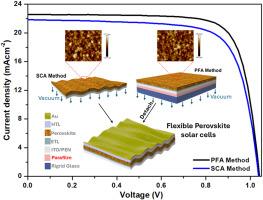Parafilm-assisted fabrication of flexible perovskite solar cells to improve efficiency
IF 6.3
2区 材料科学
Q2 ENERGY & FUELS
引用次数: 0
Abstract
Flexible perovskite solar cells (f-PSCs) are lightweight and bendable, making them ideal for powering portable and wearable devices on various surfaces and structures. However, the flexibility of the substrate polyethylene naphthalate (PEN) used in f-PSCs makes it challenging to control the morphology of the perovskite layer during the fabrication process, thereby leading to low device performance. Additionally, the difference in thermal expansion between the PEN and other functional layers causes deformation during the heating process. In this work, we demonstrate a promising strategy for fabricating efficient f-PSCs using Parafilm-based thermoplastic materials to adhere the flexible substrate to a rigid glass, achieving smooth, high-quality perovskite films. Consequently, solar cells achieve power conversion efficiency of over 18 % under 1 sun illumination. Furthermore, the stability of f-PSC under different bending conditions (convex/concave under 8 mm bending radius) over time is also investigated. It is found that prolonged convex bending for seven days reduces the performance by 47 %, while it is only 13 % for concave bending. The greater decline in photovoltaic performance during prolonged convex bending is ascribed to the line cracks on the perovskite layer and reduced ITO layer conductivity.

辅助制备柔性钙钛矿太阳能电池以提高效率
柔性钙钛矿太阳能电池(f-PSCs)重量轻,可弯曲,使其成为各种表面和结构上的便携式和可穿戴设备供电的理想选择。然而,用于f- psc的衬底聚萘二甲酸乙二醇酯(PEN)的灵活性使得在制造过程中控制钙钛矿层的形态具有挑战性,从而导致器件性能较低。此外,PEN与其他功能层之间的热膨胀差异导致在加热过程中变形。在这项工作中,我们展示了一种有前途的策略,即使用基于parafilm的热塑性材料将柔性衬底粘附到刚性玻璃上,以制造高效的f-PSCs,从而获得光滑的高质量钙钛矿薄膜。因此,在1个太阳照射下,太阳能电池的功率转换效率超过18%。此外,还研究了f-PSC在不同弯曲条件下(弯曲半径为8 mm的凸/凹)随时间的稳定性。结果发现,延长7天的凸弯曲可使性能降低47%,而凹弯曲仅降低13%。在长时间的凸弯曲过程中,光伏性能的较大下降归因于钙钛矿层上的线裂纹和ITO层电导率的降低。
本文章由计算机程序翻译,如有差异,请以英文原文为准。
求助全文
约1分钟内获得全文
求助全文
来源期刊

Solar Energy Materials and Solar Cells
工程技术-材料科学:综合
CiteScore
12.60
自引率
11.60%
发文量
513
审稿时长
47 days
期刊介绍:
Solar Energy Materials & Solar Cells is intended as a vehicle for the dissemination of research results on materials science and technology related to photovoltaic, photothermal and photoelectrochemical solar energy conversion. Materials science is taken in the broadest possible sense and encompasses physics, chemistry, optics, materials fabrication and analysis for all types of materials.
 求助内容:
求助内容: 应助结果提醒方式:
应助结果提醒方式:


